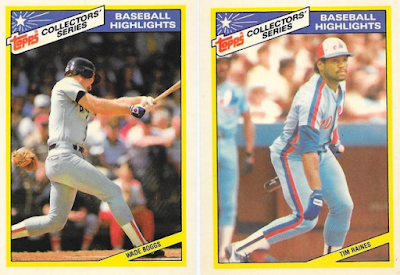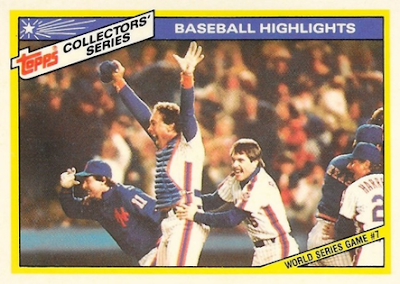THE TOPPS WOOLWORTH BOX SETS
Russell Streur
For decades, Woolworth stores defined Main Street retailing in the United States. Thousands of stores operated across the country selling everything from alarm clocks to parakeets and parchesi games and zebra-pattern evening dresses in the general merchandise version of the five and dime chain. Barbie dolls and Superman comic books could be found in the aisles, and Easy-Bake ovens, and skateboards and baseball cards. Lots of baseball cards. In the junk wax era, the company partnered with Topps and produced annual exclusive boxed sets, eventually settling on a five-year run of season highlights printed on high gloss card stock. It took a couple years to find the formula.
The first effort arrived in stores in 1985, in a 44-card set
of all-time record holders carrying the Woolworth brand on the box. A mix of black-and-white and color
photographs are framed by a false wood border that faintly recalls the Topps
1962 design. The player’s name and team
are centered on a yellow plaque at the bottom of the card. The set ranges from Hank Aaron’s 755 home
runs to Cy Young’s 511 career wins. Many
of the names are instantly recognizable—Ernie Banks, Rickey Henderson, and
Nolan Ryan to name three. The inclusion of
other players may be less obvious.
Johnny Frederick, who hit a record six pinch hit home runs for the
Brooklyn Dodgers in 1932, is in the set.
So are season extra base hit leaders Earl Webb (67 doubles in 1931 for
the Red Sox, Card 37) and Owen Wilson of the Pittsburgh Pirates (36 triples in
1912, Card 41).
Many on-line sources attribute the 1986 Champion Superstars set as a Woolworth product though it doesn’t carry a Woolworth brand. Priced at a standard $1.99, it employs the soon-to-be standard 33 high-gloss photo card format and consists of batting, home run and RBI leaders in the two major leagues for the ten years between 1976 and 1985. Visually, it is not an exciting set. Except for a handful of cards, the photographs are all posed—ordinary bat-on-shoulder fare or stock portraits. All the expected names are in the set—Wade Boggs, George Brett, Rod Carew, Reggie Jackson and Mike Schmidt as examples. The surprise is Bobby Grich, who had his career year in the strike-shortened 1981 campaign and tied for the home run lead in the American League with 22. Gorman Thomas pictured in Seattle Mariners garb on card 30 is just plain wrong. In The Bible of Baseball, that blue-collar Wallbanger is now and always and forever a Milwaukee Brewer.
Topps issued its first Baseball Highlights set in 1987. Sources again list it as Woolworth set, again in the absence of a brand. A diagonal Collectors’ Series banner cuts across the top left, balanced by a parallel card title in the lower left. On-field, live-action photographs give the set a colorful immediacy. There are exceptions, notably the first card in the set, a retro portrait of Steve Carlton posed against a cloudless blue sky that commemorates the pitcher’s 4,000th strikeout. The next five cards chronicle other 1986 regular season milestones including Rickey Henderson’s 600th stolen base, Jim Rice’s 2000th hit and Don Sutton’s 300th win.
Then, ten cards feature the season’s batting and pitching
leaders and rookies of the year. The
rest of the set is devoted to the post-season.
Marty Barrett is pictured midway through his 11-hit ALCS MVP series on
card 17 and the NLCS MVP Mike Scott is shown on card 18, though the card is
titled for his Cy Young award. The
remaining 15 cards focus on the back and forth of the classic seven-game World
Series duel between the Red Sox and the Mets.
Mercifully for Bill Buckner, his 10th inning error in Game Six is not
shown. Instead, Ray Knight’s earlier hit
in the inning is given top billing.
1986 Season Batting Leaders (Left: Wade Boggs, AL, .357 Average, Card 10. Right:
Tim Raines, NL, .334 Average, Card 11.)
Woolworth began distributing a branded Highlights set in
1988. It followed the same order as the
original set—the first cards consisting of 1987 season milestones, followed by
the league leaders and award winners. Dave Righetti gets his own card as AL Fireman
of the Year, but the award for his NL counterpart Steve Bedrosian is excluded
in favor of Bedrosian’s Cy Young award on card 10. The balance of the box is devoted to the
league championship playoffs and the World Series.
The 1988 set also introduced a new card design. A red banner across the top of the card
carries the Woolworth imprint in white lettering. Beneath, the Baseball Highlights title of the
set is printed in red against a yellow text box. A blue border frames a photograph of on-field
action. There are two exceptions. Card 11 shows a sour-faced Roger Clemens
slouched against the back wall of a dugout, and Wade Boggs is shown pre-game in
a batting cage on card 13. With changes
in the color combinations, this design will last through the end of the
Highlights production in 1991.
1987 Highlights (Left: Eddie Murray, Switch Hit HRs in 2 Consecutive Games, Card 5. Right: Mike Schmidt, Sets HR Mark at 3rd Base, Card 7.)
Topps applied a new organization to the 1989 set. Awards begin the set and are limited to six
cards—the 1988 AL and NL MVPS, the Cy Young winners, and the Rookies of the
Year for leach league. Regular season
highlights follow and include George Bell’s three Opening Day home runs, Tom
Browning’s perfect game, and Randy Johnson’s September debut as the tallest
player ever to take the field in a major league game.
Pat Tabler of the Kansas City Royals also gets a card,
number 18, for his remarkable 7th hit in 8 bases-loaded at-bats in 1988. A clutch hitter without compare, Tabler
batted just under .500 with the bases loaded in his career, adding 11 walks and
9 sacrifice flies to his production. He
also reached base twice on errors and once by being hit by a pitch.
The next four cards recount the league championship
series. The throttling of the Oakland
A’s in five games by Orel Hershiser and Kirk Gibson and the rest of the Los
Angeles Dodgers is documented on cards 23 through 33. Gibson’s dramatic game-winning home run in
Game One is pictured on card 24. Mark McGwire’s
Game Three winner is pictured on card 27.
The 1990 set follows the new pattern. Awards again begin the set and are limited to
six cards—the 1989 AL and NL MVPS (Robin Yount and Kevin Mitchell), the Cy
Young winners (Brett Saberhagen and Mark Davis, and the Rookies of the Year for
leach league (Gregg Olson and Jerome Walton).
The bridge to the post-season cards is built on season highlights. It’s a longer bridge than normal and includes
Vince Coleman’s 50 consecutive stolen bases on card 10, Dale Murphy’s pair of
three-run homeruns in the same inning on card 15, and Ryne Sandberg’s
single-season record of 90 games at second base without an error on card
21.
Only 11 cards (numbers 23 through 33) are needed to cover
the postseason and four-game sweep of the Giants by the Oakland A’s in
1989. A portrait of Dave Stewart marks
his World Series MVP award on card 33.
The card shows the pitcher refusing to look at the camera. Instead, Stewart looks off to the left, with
the beginnings of a sneer, as if daring the Devil himself to come to the plate
and take a swing or two. Stewart gives
the same look on Card 449 of the Bowman set that year.
The 1991 Highlights set is the final and the most attractive
of the series. The red banner of the
1988 set returns along with the white Woolworth lettering. A yellow border replaces the 1988 blue, and
the two colors also trade places for the title background. The color schemes make good bookends.
For the last time, the first six cards are reserved for award
winners with regular season highlights leading up the post-season half of the
set. A collegiate Alex Fernandez in a
suit and tie collecting the Golden Spikes award is pictured on card 11.
Bobby Thigpen’s 57 saves on card 21 is also featured. Highlights also include Dave Parker hitting
the 500th double of his career on card 16, but Parker in a Milwaukee Brewers
uniform is just plain wrong. In The
Bible of Baseball, the one and only Cobra is now and always and forever a
Pittsburgh Pirate.
Post-season cards begin on number 23, where Rob Dibble and
Randy Myers of the Cincinnati Reds share the space as co-MVPs of the 1990
NLCS.
The Reds disposed of the A’s in four games in the World
Series that year, and the cards for the Fall Classic mirror the lopsided nature
of the contest. Of the nine cards
devoted to the Series, only one shows an A’s highlight—Rickey Henderson’s
single and two doubles in Game One on card 26.
Everything else is all Queen City—Eric Davis’s first pitch home run in
Game One, Billy Hatcher’s seven consecutive hits in Games One and Two, Chris
Sabo’s pair of home runs in Game Three, and Jose Rijo’s wins on the mound in
Games One and Four.
The World Series Celebration cards in the sets evoke the World
Series Thrills cards Topps produced in the 1950s and 1960s. Upper: Mets Celebrate Amazin’ Comeback, card
32, 1986 Baseball Highlights.
Lower: Reds Celebrate after
Sweeping A’s in Four, card 32, 1990 Baseball Highlights.
Woolworth founder Frank Winfield Woolworth built the world’s
tallest building in the early 1910s, paying much of the cost for the Manhattan
skyscraper in cash out of pocket. The
good times lasted sixty years. Eventually,
beset by competitors, suburban malls, and bad marketing strategies, Woolworth
fell from its pedestal, out of customers and out of chances to recover. In 1997, the company was delisted from the
Dow Jones Industrial Average, and the once formidable market symbol Z
disappeared from the financial pages soon afterwards. Today, the legal successor Foot Locker and
the “Cathedral of Commerce” at 233 Broadway are the only reminders of past
glory.
It’s debatable whether Main Street is better off with or
without the Woolworth store on the corner. It’s debatable whether baseball card
collecting is better off with or without these small box sets. But don’t debate whether to try the bubble
gum that somehow survived intact the decades stuck to the back of the Gorman Thomas
card in the Champion Superstars box. Just don’t give into the temptation. That desiccated confection from 1986 will
instantly dissolve in your mouth, and you’ll need some Listerine to clear out an
unpleasant aftertaste. Thomas would
recommend a frothier beverage, something with barley and hops.


















Miss these and the Fleer box sets from the 80's and 90's. I'd love to see Target collaborate with Topps to produce a 33 or 44 card box set at a reasonable price.
ReplyDeleteBy the way... the 1985 Woolworth set is one of my favorite box sets from the 80's. Love the checklist and the design with the wood frames.